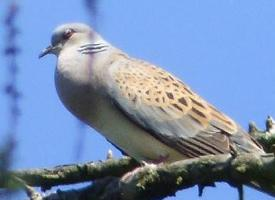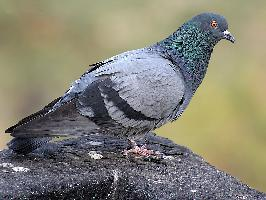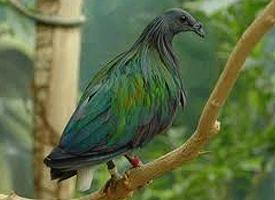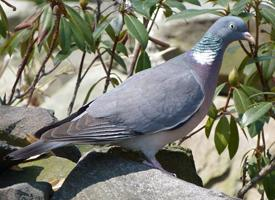
Veszélyeztetettség
| Rettenthetetlen |
Állatleírás
The European turtle dove (Streptopelia turtur), often simply referred to as the turtle dove, is a member of the bird family Columbidae, which includes doves and pigeons. This species, characterized by its distinctive gentle purring calls, is a symbol of love and peace in various cultures, immortalized in literature and song for its mournful yet beautiful cooing.Physically, the European turtle dove is a medium-sized bird, measuring approximately 26 to 28 centimeters in length and weighing around 100 to 180 grams. Its plumage is a delicate mixture of colors, primarily featuring a soft, sandy or grayish-brown back, with a pinkish breast that adds to its graceful appearance. The wings display a striking pattern with black and white striped patches, which are most visible during flight. Its tail is marked by a distinctive white border and central black stripe, which contrasts sharply with the rest of its body. The neck carries a unique feature: a patch of black and white stripes that gives it a distinguished look among other dove species.
Turtle doves have a wide range across Europe and parts of Asia and migrate to the African continent to spend the winter. Their preferred habitats include open countryside with scattered trees and bushes, where they can find food and shelter. They are often found in agricultural lands, woodland edges, and even in parks and gardens within urban areas.
Their diet primarily consists of seeds from grasses and cereals, but they also consume small invertebrates, berries, and other plant material during the breeding season to supplement their nutrition. This diet supports them in their migratory journey, which can be quite taxing given the distances covered.
Breeding typically begins in late spring and can continue into the summer. The European turtle dove is known for its strong pair bonds, with couples often returning to the same nesting sites year after year. Nests are relatively simple structures, built by both male and female, located in trees or bushes. The female usually lays two creamy-white eggs, which are incubated by both parents over a period of about two weeks. The chicks are altricial, meaning they are born in a relatively undeveloped state and require significant parental care before they can leave the nest.
Despite its once-abundant status, the European turtle dove is now facing a rapid decline in population, attributed to a combination of factors including habitat loss due to agricultural intensification and changes in land use, hunting during migration, and climate change. This decline has led to its classification as vulnerable by the International Union for Conservation of Nature (IUCN), prompting conservation efforts to protect this species and its habitat.
Efforts to conserve the European turtle dove include habitat restoration, research on migration and threats, and legislation to reduce hunting pressure. These initiatives aim to ensure that the gentle coo of the turtle dove continues to grace the landscapes of Europe and Asia, embodying peace and love for future generations to appreciate.
Hasonló állatok
Új állatfotók
Top 10 állat
- Dolphin gull (Leucophaeus scoresbii)
- Japanese macaque (Macaca fuscata)
- Stone loach (Barbatula barbatula)
- Russian tortoise (Testudo horsfieldii)
- Galápagos tortoise (Geochelone nigra complex)
- Greek tortoise (Testudo graeca)
- Diana monkey (Cercopithecus diana)
- Common flying dragon (Draco volans)
- Moustached guenon (Cercopithecus cephus)
- Galápagos penguin (Spheniscus mendiculus)


